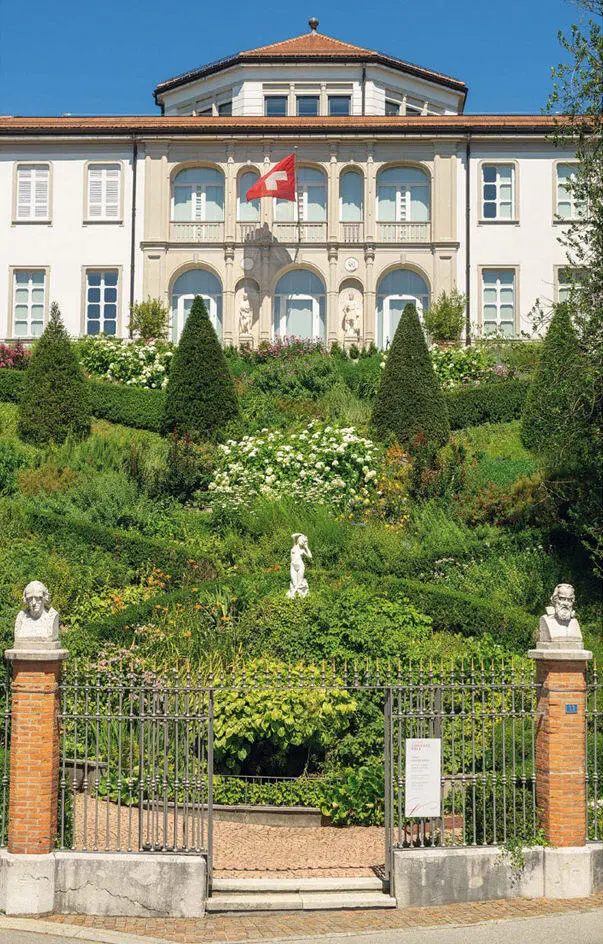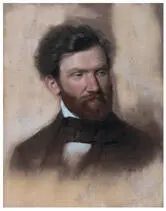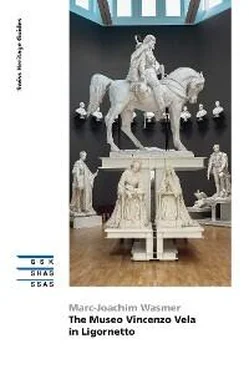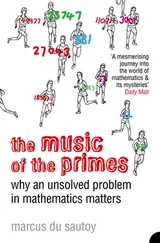Marc-Joachim Wasmer
Museo Vincenzo Vela in Ligornetto
Canton of Ticino
Introduction Introduction Ligornetto is a small village that lies in the large Mendrisiotto plain in the southernmost tip of the canton of Ticino, once geographically part of Lombardy. It is formed by a triangle of streets to the west of the north-south motorway (A2, Mendrisio exit, heading towards Stabio/Varese). It would hardly be distinguishable from the surrounding villages were it not for the historic villa standing high on the hill. Built in 1862–1865 in the midst of a vast park, the building with its elegant facade and central lantern tower was once the splendid studio-residence of Vincenzo Vela (1820–1891), the foremost artist’s house still maintained in Switzerland. Today it is the home of the Museo Vincenzo Vela, administered by the Swiss Federal Office of Culture. Vela was a celebrated 19th century sculptor, a leading exponent of verism (see Glossary, p. 77), who was equally at home in Switzerland and Italy. Having achieved fame during the years of the unification of Italy, a period known as the Risorgimento, he returned to Ligornetto from Turin in 1867 and put the original plaster models of almost all his works on public display in a specially-designed room of his studio-home. Acting on Vincenzo’s wishes, in 1892, his son Spartaco Vela (1854–1895) bequeathed the property to the Swiss Confederation on the condition that it be used as a museum or a school. Since its opening to the public in 1898, the museum has been rearranged several times, most recently by the architect Mario Botta in 1997–2001. Representing Vincenzo Vela, in addition to his plaster models and original casts, the museum features drawings and preliminary models made in terracotta and plaster; his brother Lorenzo Vela (1812–1897) is represented by painted and sculptural works; and Spartaco Vela, by paintings, drawings and ceramics. This body of family works is complemented by a library, paintings and drawings by artist friends from Lombardy and Piedmont, and a collection of period photographs that is unique in Switzerland. A look at Museo Vincenzo Vela from the South, 2019.
Vincenzo Vela (1820–1891): A Ticinese Sculptor in the Service of the Risorgimento Vincenzo Vela (1820–1891): A Ticinese Sculptor in the Service of the Risorgimento The Roman numerals in bold indicate the number of the exhibition room. Please see the floorplan of the ground floor on the back cover flap inside for orientation.
Lorenzo Vela (1812–1897 Lorenzo Vela, The Monkey Carving a Chicken , undated, plaster original.
)
Spartaco Vela (1854–1895)
Villa Vela: Artist’s House and Museum
Museo Vincenzo Vela Today
Addenda
Glossary
Biographical notes
Biography of Vincenzo Vela
Selected bibliography
Sources of illustrations, Author, Information
A New Look at a Forgotten Art by Gianna A. Mina
Ligornetto is a small village that lies in the large Mendrisiotto plain in the southernmost tip of the canton of Ticino, once geographically part of Lombardy. It is formed by a triangle of streets to the west of the north-south motorway (A2, Mendrisio exit, heading towards Stabio/Varese). It would hardly be distinguishable from the surrounding villages were it not for the historic villa standing high on the hill. Built in 1862–1865 in the midst of a vast park, the building with its elegant facade and central lantern tower was once the splendid studio-residence of Vincenzo Vela (1820–1891), the foremost artist’s house still maintained in Switzerland. Today it is the home of the Museo Vincenzo Vela, administered by the Swiss Federal Office of Culture.
Vela was a celebrated 19th century sculptor, a leading exponent of verism (see Glossary, p. 77), who was equally at home in Switzerland and Italy. Having achieved fame during the years of the unification of Italy, a period known as the Risorgimento, he returned to Ligornetto from Turin in 1867 and put the original plaster models of almost all his works on public display in a specially-designed room of his studio-home. Acting on Vincenzo’s wishes, in 1892, his son Spartaco Vela (1854–1895) bequeathed the property to the Swiss Confederation on the condition that it be used as a museum or a school. Since its opening to the public in 1898, the museum has been rearranged several times, most recently by the architect Mario Botta in 1997–2001.
Representing Vincenzo Vela, in addition to his plaster models and original casts, the museum features drawings and preliminary models made in terracotta and plaster; his brother Lorenzo Vela (1812–1897) is represented by painted and sculptural works; and Spartaco Vela, by paintings, drawings and ceramics. This body of family works is complemented by a library, paintings and drawings by artist friends from Lombardy and Piedmont, and a collection of period photographs that is unique in Switzerland.

A look at Museo Vincenzo Vela from the South, 2019.
Vincenzo Vela (1820–1891): A Ticinese Sculptor in the Service of the Risorgimento
The Roman numerals in boldindicate the number of the exhibition room. Please see the floorplanof the ground floor on the back cover flap inside for orientation.
Vincenzo Vela was born in Ligornetto on 3 May 1820 to Giuseppe Vela, a small-holder, and his wife Teresa, née Casanova. At the age of nine he was apprenticed as a stonecutter in the Besazio quarries, from the outset displaying a gift for craftsmanship. His elder brother Lorenzo, also a sculptor, recognized his talent and took Vincenzo with him to Milan, where he worked as a stonecutter on the Cathedral site while also studying at the Brera Fine Art Academy, and the Scuola d’Ornato (School of Decoration) in particular. Influenced by Francesco Hayez’ painting and the work of the Tuscan sculptor Lorenzo Bartolini, the young Vela’s style took on a marked realism, in contrast to the dry classicism of Canova’s followers. An extremely gifted student, he won many competitions and soon became the spokesman for the hopes of the new generations. In 1842, after winning a gold medal in Venice, he completed his studies and set up on his own.
Early recognition in Milan

Enrico Gamba, Portrait of Vincenzo Vela , c. 1857, colour pastels on paper.
Immediately after Vela’s first commission, the Monument to Giuseppe Maria Luvini, Bishop of Pesaro ( VIII) for the new city hall in Lugano, which won him major recognition at the Brera exhibition of 1844, Vela completed sepulchres for Maddalena Adami-Bozzi in Pavia and Cecilia Rusca in Locarno (c. 1845–1846, XX). The two sculptural groups he created were innovative in Italian funerary art: for the first time mourning figures, usually depicted as allegorical characters, were represented with touching immediacy, portrayed with the faces of the deceased’s family, and dressed in everyday clothes.
Although this genre was a key feature of Vela’s art from this moment on, he nonetheless explored more ‘worldly‘ themes and genres, including the portrait. In fact, in 1846 he executed for Duke Giulio Litta
Читать дальше














